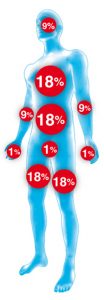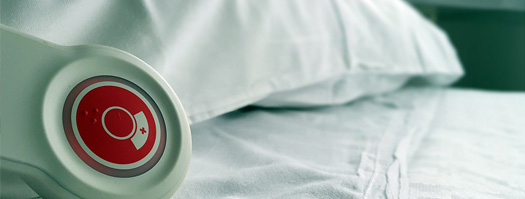Five factors should be considered in order to determine the severity of a burn.
1. The circumstances
You need to identify the exposure time (the longer the exposure time, the deeper the burn) and the type of substance responsible for the burn. If the burn is chemical or electrical in origin, urgent medical assistance is essential.
2. Patient profile1
Age is a key factor in the prognosis. Burns are more serious in children under 5 years old and in people over 60 years old as their healing and defence capabilities against infections are more limited.
Some chronic diseases (diabetes, heart failure, renal failure, immunosuppression) greatly worsen the prognosis of a burn.
3. The site
Some sites complicate treatments and increase risks to life and function.
For example, burns to the face may cause acute respiratory distress because of the rapid formation of oedema.
Burns to the hands are common and may cause functional handicapping consequences.
4. The extent of the burn2
This is assessed using the Wallace scale with the palm of the hand which represents approximately 1% of body surface area.

If the affected surface is 10% of body surface area in adults or 5% in children or if you consider it necessary, you should contact the Emergency Services.
Wallace Rule of 9 in adults
Each part of the body represents 9% or a multiple of 9% of body surface area:
- Head: 9%
- Chest 2 x 9%
- Abdomen: 2 x 9%
- Upper limbs: 2 x 9%
- Lower limbs: 4 x 9%
- Genital regions: 1%
5. Depth3
In order to establish the severity of a burn, depth must also be taken into account.
| Stage | Clinical appearance | Evolution |
| 1st degree | Bright red lesion + pain Epidermis |
4 to 5 days |
| 2nd degree superficial | Bright red lesion + pain + blisters Total epidermis + papillary dermis |
10 to 14 days |
| Deep 2nd degree | White/pink + pain + blisters Total epidermis + papillary dermis + reticular dermis |
3 to 5 weeks |
| 3rd degree | White or black + loss of sensation Total epidermis + total dermis |
Transplant required |
How to assess the depth of a burn?3
First degree
First degree burns involve damage only to the epidermis.
It can be recognised from the absence of blisters and presence of painful erythema.
Recovery occurs untreated in 4 to 5 days with no complications.
Superficial second degree
Superficial second degree involves damage to the epidermis and the papillary dermis.
Morphologically, it can be recognised by red, well vascularised, very tender skin and the consistent presence of blisters.
Healing occurs untreated in 10 to 14 days without permanent complications although dark blemishes may take longer to disappear.
Deep second degree
Deep second degree burns involve destruction of the epidermis, papillary dermis and reticular dermis. Like superficial second degree burns, these burns cause blisters, although the skin appears white/pink in colour, poorly vascularised and relatively non-tender.
A deep second degree burn recovers in 3 to 5 weeks in the absence of infection and leaves scars.
Third degree
Third degree burns involve complete destruction of the skin including all of the epidermis, dermis and occasionally hypodermis. It appears as skin necrosis without blisters, more or less dark in colour (ranging from white to black passing through brown) with total loss of sensation.
Because the epidermal cells disappear completely, healing does not occur untreated. Permanent skin closure is then only obtained through surgery.

